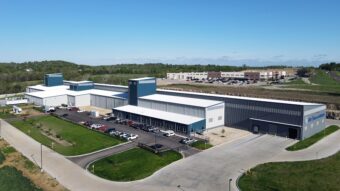When analysts list the reasons why shopping malls are struggling, they inevitably point to technology. This makes sense: Tech and online shopping have certainly reshaped the shopping habits of the U.S. consumer. For many, the rise of ecommerce has made the sprawling indoor shopping mall a relic.
But Brian Zrimsek, chief product officer of Solon, Ohio-based MRI Software, says that technology can be a lifeline for malls.
With technology, mall owners can not only access mountains of data on the shopping habits of their customers, they can analyze this data to make changes in the ways they operate their malls, changes that can boost the amount of time and money shoppers spend at their centers.
“I can remember spending plenty of time at Radio Shack, CompUSA, Circuit City, Sears and Linens ‘N Things. Now those have either gone by the wayside or are struggling,” Zrimsek said. “My kids don’t hang out at the mall. Technology has changed all this. Kids instead of hanging out at the malls are hunkering down with their tech at home. That has changed the nature of foot traffic.”
Most malls, though, haven’t changed to meet the evolving shopping habits of their customers, Zrimsek said. Go into most malls across the country and you’ll see the same mix: two to three anchor stores, rows of smaller retailers and a food court.
Malls can’t offer the same product and expect today’s shoppers to spend their entire day wandering their floors, Zrimsek said. Instead, they need to study their costumers’ shopping habits and make the changes that will allow them to adapt along with their shoppers.
Data is key
MRI Software provides its commercial real estate costumers with software that they can use to analyze the number of shoppers that come to their retail centers and malls each day, where they spend most of their time, which retail tenants are performing well and which ones are struggling.
Armed with this data, mall owners can make changes designed to boost their monthly revenue.
Say a mall schedules a tree-lighting ceremony to start the holiday shopping season. A big crowd comes to see Santa. That’s great, right?
Not necessarily.
“If all people do is see the tree-lighting and Santa and then leave, that’s not much help to your mall,” Zrimsek said. “Are they spending dollars elsewhere? That’s the key.”
Mall owners can use software to analyze the sales of their tenants, and can then determine which ones are underperforming. Zrimsek said that mall owners can compare the sales of the six casual restaurants in their food courts year-over-year, per-square-foot or on a daily basis to see which ones are generating the most income, and which are generating the least.
They might look at retail categories across several of the retail centers they own, to see if an apparel store is struggling in one indoor mall but perhaps thriving in a nearby strip center. Owners can then use that information to determine if the apparel store might simply perform better in an open-air strip center than it will in an enclosed shopping mall.
Mall owners can even use the data they gain from software to refute untrue claims from their retail tenants.
Zrimsek points a letter that a mall operator recently received from one of its fast-casual restaurant tenants. The tenant claimed that the mall’s recent renovations were dragging down its sales. The mall operate studied the sales data from its management software to discover that the sales at every other fast-casual restaurant in the same center were actually on an upward trend.
The mall owner than looked at the sales numbers from the complaining fast-casual restaurant in other centers. The owner discovered that the restaurant’s sales were also falling at these other centers, centers that were not in the middle of renovation projects.
“That owner was able to write back to the tenant and say, ‘Dear Tenant, it’s not us, it’s you,” Zrimsek said.
Mall owners can use data to determine if they need to change the layout of their centers or rely on special events to draw customers to under-traveled portions of their malls.
Zrimsek cites the example of a West Coast mall that was thriving. The only problem? One corridor of the mall was not attracting the same amount of traffic. This corridor was not a natural path for shoppers, and the stores lining it were not generating the same amount of sales.
“When you put sales-per-square-foot on the site plan, that one area lit up like a bright-red beacon,” Zrimsek said. “It wasn’t just one retailer that was struggling, it was all the retailers in that corridor. As a landlord, you can use that information to figure out ways to drive traffic there. Do you need to put in a retailer with a bigger name, more brand cache’? Do you need to change the configuration of the mall to get people down that corridor? Do you need to hold special events in that section of the mall?”
Zrimsek said that this mall operator was still weighing options for the under-traveled corridor. The owner was contemplating possible physical structural changes and bringing in a different mix of merchants for the corridor.
Making better choices
Mall owners can use management software and the data it generates to make better tenanting decisions, Zrimsek said.
Say an owner wants to bring a nail salon to its retail center. Instead of just bringing in a random salon, owners can analyze the performance of the salons in their other retail centers. They can determine which salons average the most sales per-square-foot and which ones attract the greatest number of customers.
Owners can then bring those stronger salons to their other retail centers.
Mall owners might automatically think that a trendy retailer such as grocer Whole Foods makes sense for their malls or strip centers. And maybe that Whole Foods will bring in plenty of shoppers.
But if those shoppers simply buy their groceries and leave the center, that Whole Foods might not be as powerful a tenant as owners think, Zrimsek said. A better choice might be a top retailer such as Nordstrom.
Shoppers might visit the Nordstrom and then spend money at the retailers surrounding it, something that might not happen with the Whole Foods, Zrimsek said.
“Some landlords can get complacent,” Zrimsek said. “They expect their retail centers to always work the same way. They don’t understand which categories are performing better than others. They continue to run their centers as they always have. They can’t do that today.”



